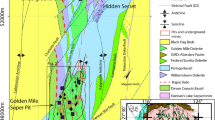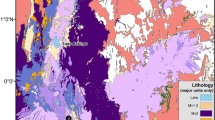Abstract
Whereas colored andesine/labradorite had been thought unique to the North American continent, red andesine supposedly coming from the Democratic Republic of the Congo (DR Congo), Mongolia, and Tibet has been on the market for the last 10 years. After red Mongolian andesine was proven to be Cu-diffused by heat treatment from colorless andesine starting material, efforts were taken to distinguish minerals sold as Tibetan and Mongolian andesine. Using nanosecond laser ablation–inductively coupled plasma mass spectrometry (ICPMS), the main and trace element composition of andesines from different origins was determined. Mexican, Oregon, and Asian samples were clearly distinguishable by their main element content (CaO, SiO2 Na2O, and K2O), whereas the composition of Mongolian, Tibetan, and DR Congo material was within the same range. Since the Li concentration was shown to be correlated with the Cu concentration, the formerly proposed differentiation by the Ba/Sr vs. Ba/Li ratio does not distinguish between samples from Tibet and Mongolia, but only between red and colorless material. Using femtosecond laser ablation multi-collector ICPMS in high-resolution mode, laboratory diffused samples showed variations up to 3‰ for 65Cu/63Cu within one mineral due to the diffusion process. Ar isotope ratio measurements proved that heat treatment will reduce the amount of radiogenic 40Ar in the samples significantly. Only low levels of radiogenic Ar were found in samples collected on-site in both mine locations in Tibet. Together with a high intra-sample variability of the Cu isotope ratio, andesine samples labeled as coming from Tibet are most probably Cu-diffused, using initially colorless Mongolian andesines as starting material. Therefore, at the moment, the only reliable source of colored andesine/labradorite remains the state of Oregon.

Cu diffusion can be used to turn a plain, colorless andesine into a red gemstone. Cu and Ar isotope ratios in combination with main and trace elemental analysis can appoint andesine to thrie origin in Oregon, Mexico and Asia. In this study, red andesines sold as coming from Tibet and Mongolia are revealed to be most probably Cu-diffusion treated.









Similar content being viewed by others
References
James R (2008) Sunrise over Oregon. http://www.yourgemologist.com/ISGForumsBoard/showthread php?p=24578post24578, accessed 10 June 2009
HRJ4 (2009) State emblems; State Boundary: chapter 186
Hofmeister AM, Rossman GR (1985) Exsolution of metallic copper from Lake County labradorite. Geology 13:644–647
GIA (2009) Introduction. GIA: News from Research (Special Issue on Red Feldspar)
Brooks-Pike L (2006) What’s in a name? http://www.yourgemologist.com/ISGForumsBoard/showthread.php?t=1372&highlight=Labradorite+Feldspar, accessed 18 August 2010
James R (2008) Answers on “andesine/labradorite” color source. http://www.yourgemologist.com/ISGForumsBoard/showthread php?t=3412, accessed 10 June 2009
Emmett JL, Scarratt K, McClure SF, Moses T, Douthit TR, Hughes R, Novak S, Shigley JE, Wang WY, Bordelon O, Kane RE (2003) Beryllium diffusion of ruby and sapphire. Gems Gemol 39:84–135
James R (2008) ISG report on the diffusion treatment of andesine. http://www.schoolofgemology.com/GemResearch/ISGAndesineReport.html, accessed 18 August 2010
Rossman GR (2009) The red feldspar project. GIA: News from Research (Special Issue on Red Feldspar)
Fritsch E, Rondeau B, Mocquet B, Lulzac Y (2008) “Red andesine” from China: possible indication of diffusion treatment. Gems Gemol 44:166
Thirangoon K (2009) Observation on effects of heating and copper diffusion in feldspar (an on-going research). GIA: News from Research (Special Issue on Red Feldspar)
Emmett JL, Douthit TR (2009) Copper diffusion in plagioclase. GIA: News from Research (Special Issue on Red Feldspar)
Abduriyim A (2008) Visit to andesine mines in Tibet and Inner Mongolia. Gems Gemol 44:369
Abduriyim A (2009) Gemological properties of andesine collected in Tibet and Inner Mongolia. GIA: News from Research (Special Issue on Red Feldspar)
McClure SF (2009) Observations on identification of treated feldspar. GIA: News from Research (Special Issue on Red Feldspar)
McClure SF, Shen AH (2008) Coated tanzanite. Gems Gemol 44:142–147
Zhu XK, O'Nions RK, Guo Y, Belshaw NS, Rickard D (2000) Determination of natural Cu-isotope variation by plasma-source mass spectrometry: implications for use as geochemical tracers. Chem Geol 163:139–149
Mason TFD, Weiss DJ, Chapman JB, Wilkinson JJ, Tessalina SG, Spiro B, Horstwood MSA, Spratt J, Coles BJ (2005) Zn and Cu isotopic variability in the Alexandrinka volcanic-hosted massive sulphide (VHMS) ore deposit, Urals, Russia. Chem Geol 221:170–187
Markl G, Lahaye Y, Schwinn G (2006) Copper isotopes as monitors of redox processes in hydrothermal mineralization. Geochim Cosmochim Acta 70:4215–4228
Gonzalez J, Dundas SH, Liu CY, Mao XL, Russo RE (2006) Assessment of the precision and accuracy of thorium (232Th) and uranium (238U) measured by quadrupole based inductively coupled plasma-mass spectrometry using liquid nebulization, nanosecond and femtosecond laser ablation. J Anal At Spectrom 21:778–784
Horn I, von Blanckenburg F (2007) Investigation on elemental and isotopic fractionation during 196 nm femtosecond laser ablation multiple collector inductively coupled plasma mass spectrometry. Spectrochim Acta B 62:410–422
Kuhn HR, Pearson NJ, Jackson SE (2007) The influence of the laser ablation process on isotopic fractionation of copper in LA-MC-ICP-MS. J Anal At Spectrom 22:547–552
Krzemnicki MS (2004) Red and green labradorite feldspar from Congo. J Gemmol 29:15–23
Mason TFD, Weiss DJ, Horstwood M, Parrish RR, Russell SS, Mullane E, Coles BJ (2004) High-precision Cu and Zn isotope analysis by plasma source mass spectrometry. Part 1. Spectral interferences and their correction. J Anal At Spectrom 19:209–217
Fontaine GH, Hattendorf B, Bourdon B, Gunther D (2009) Effects of operating conditions and matrix on mass bias in MC-ICPMS. J Anal At Spectrom 24:637–648
Barling J, Weis D (2008) Influence of non-spectral matrix effects on the accuracy of Pb isotope ratio measurement by MC-ICP-MS: implications for the external normalization method of instrumental mass bias correction. J Anal At Spectrom 23:1017–1025
Vanhaecke F, Dams R, Vandecastelle C (1993) Zone model as an explanation for signal behavior and non-spectral interferences in inductively-coupled plasma-mass spectrometry. J Anal At Spectrom 8:433–438
Groh S, Garcia CC, Murtazin A, Horvatic V, Niemax K (2009) Local effects of atomizing analyte droplets on the plasma parameters of the inductively coupled plasma. Spectrochim Acta B 64:247–254
Longerich HP, Jackson SE, Günther D (1996) Laser ablation inductively coupled plasma mass spectrometric transient signal data acquisition and analyte concentration calculation. J Anal At Spectrom 11:899–904
Giletti BJ, Shanahan TM (1997) Alkali diffusion in plagioclase feldspar. Chem Geol 139:3–20
Cherniak DJ, Watson EB (1994) A study of strontium diffusion in plagioclase using Rutherford backscattering spectroscopy. Geochim Cosmochim Acta 58:5179–5190
Cherniak DJ (2003) REE diffusion in feldspar. Chem Geol 193:25–41
Dickin AP, Muller R (1995) Radiogenic isotope geology. Phys Today 49:6–60
Fontaine GH, Hametner K, Günther D, Peretti A (2009) Identification test for copper-bearing gemstones (copper–andesine and paraiba-type tourmalines) using copper–isotope ratio determinations by femtosecond laser ablation-MC-ICPMS. Hong Kong Jewellery & Gem Fair
Acknowledgments
Prof. Igor Villa from the Institute of Geology of the University in Bern is warmly thanked for access to and substantial help with the use of the noble gas spectrometer and argon data evaluation. In addition, his comments, suggestions, and critical remarks to general and special aspects of the topic were greatly appreciated. Prof. George Rossman’s personal description of their Ar analysis procedure was very helpful in carrying out the experiments. We thank Ken Scarratt of GIA (Thailand) for providing diffusion-treated andesine samples for this research project. Dr. John Emmet’s diffusion treatment of our samples from Mongolia—carried out at his own cost and a key experiment for the interpretation of our data—is highly valued. We thank those companies that helped by supplying samples, organizing the expedition to Tibet, and being interested in the outcome of the research, whatever it may be. It was a very important, clarifying field expedition and an experience unique of its kind. Dr. Joachim Koch, Dr. Helmar Wiltsche, and Reto Glaus are thanked for software and hardware support with the laser system.
Author information
Authors and Affiliations
Corresponding author
Rights and permissions
About this article
Cite this article
Fontaine, G.H., Hametner, K., Peretti, A. et al. Authenticity and provenance studies of copper-bearing andesines using Cu isotope ratios and element analysis by fs-LA-MC-ICPMS and ns-LA-ICPMS. Anal Bioanal Chem 398, 2915–2928 (2010). https://doi.org/10.1007/s00216-010-4245-z
Received:
Revised:
Accepted:
Published:
Issue Date:
DOI: https://doi.org/10.1007/s00216-010-4245-z




